[Ebook] Indoor Gardening Houseplants 2016 USA Magazine 2016 USA, Indoor Gardening Houseplants Magazine
[Ebook] Indoor Gardening Houseplants 2016 USA Magazine – I – The Basics (Phần cơ bản)
- Dịch: Huyền Nguyễn
ENGLISH
GET THE DIRT ON WHAT IT TAKES TO CULTIVATE HEALTHY PLANTS INDOORS. START WITH A FEW POTTING SOIL POINTERS AND FERTILIZER FACTS, THEN CHOOSE THE BEST CONTAINERS FOR YOUR PLANTS AND GIVE THEM THE RIGHT LIGHT AND WATER.
- WRITER: KATE CARTER FREDERICK
- PHOTOGRAPHERS: MARTY BALDWIN, BLAINE MOATS, AND DEAN SCHOEPPNER
Get the Dirt
All plants depend on good soil for their prosperity. But all potting mixes are not created equal. The term “potting soil” is generic in the marketplace. Unless a package indicates the ingredients, it is difficult to know what you are buying. Potting soil varies considerably, but it is often little more than sterilized topsoil, which by itself is much too heavy for potted plants. Container plants need porous soil that holds some moisture but also drains well and is rich in nutrients.
For most container gardens, choose a potting mix. Ready-made packaged mixes usually contain organic matter (peat moss, coir [coconut husk], or decomposed bark) and some form of aggregate (perlite, vermiculite, or sand) in various proportions. These ingredients allow water to properly drain, enabling air to penetrate the soil.
Read the package label to determine if the mix is adequate for your plants’ needs or if you will need to add ingredients to make an ideal mix. Experiment with potting mixes to see which ones work best for your plants.
Soilless mixes drain well and dry out quickly. They’re good for starting seeds and rooting cuttings. If a lightweight mix based on peat or coir also contains sterilized soil or compost, it will hold moisture and nutrients longer, and it will add to the weight needed to keep a tall potted plant from toppling over.
Customize a potting mix based on individual plant needs and save money by adding ingredients to a standard potting mix. Potting mixes for flowering plants typically contain more organic materials that retain moisture, such as leaf mold (decomposed leaves) or compost. A moisture- holding mix usually includes water-retentive polymer crystals and suits plants that prefer damp soil. An organic potting mix suits edibles. A desertlike potting mix that contains equal parts sand, perlite, and potting soil provides porous, fast-draining conditions for cacti and succulents. Amendments, such as granular or slow-release fertilizer, compost, composted manure, and leaf mold contribute to a premium potting mix.
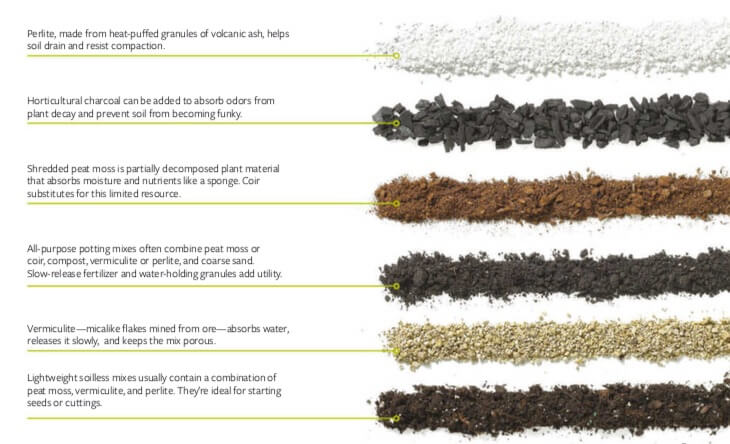
- Perlite, made from heat-puffed granules of volcanic ash, helps soil drain and resist compaction.
- Horticultural charcoal can be added to absorb odors from plant decay and prevent soil from becoming funky.
- Shredded peat moss is partially decomposed plant material that absorbs moisture and nutrients like a sponge. Coir substitutes for this limited resource.
- All-purpose potting mixes often combine peat moss or
coir, compost, vermiculite or perlite, and coarse sand. Slow-release fertilizer and water-holding granules add utility. - Vermiculite—micalike flakes mined from ore—absorbs water, releases it slowly, and keeps the mix porous.
- Lightweight soilless mixes usually contain a combination of peat moss, vermiculite, and perlite. They’re ideal for starting seeds or cuttings.
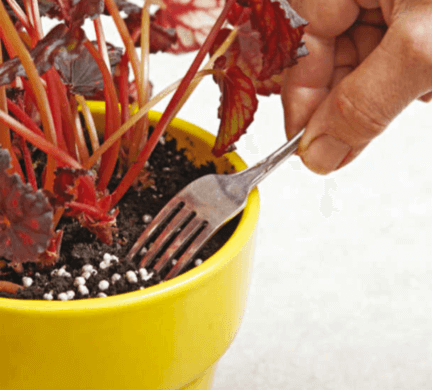
Fertilizers and More
High-performance plants need nutrients to produce vigorous foliage and bright blooms. Regular fertilizing during the growing season is important to keep potted plants healthy, because frequent watering flushes important nutrients out of the soil. More frequent fertilizing is needed by some plants, including vigorous growers, flowering plants, and those growing in soilless mix. Less frequent feeding is required by other plants, such as many foliage-type houseplants, citrus, cacti, succulents, and plants that rest or go dormant over winter.
The numbers
Although fertilizer can be called plant food, plants make their own food via photosynthesis. Fertilizer amends the soil with the nutrients plants need most. The three key nutrients are nitrogen, phosphorus, and potassium. Nitrogen is needed for stem growth and green leaves; phosphorus fuels strong roots and flowering; potassium enhances
stem strength, disease resistance, and formation of flowers and fruit. Fertilizer labels indicate the percentage of these nutrients as a series of numbers. For example, 15-30-15, which is ideal for flowering plants, means that 15 percent of the product’s weight is nitrogen; 30 percent is phosphorus; and 15 percent is potassium. An all-purpose, 30-30-30 blend suits most plants.
Types of fertilizers
Plant foods come in various forms that are applied in different ways. What matters most is that fertilizer must be dissolved to be of use to plants; soil moisture dissolves nutrients so they can be absorbed by plant roots. Water-soluble crystalline, granular, or liquid fertilizers are convenient to use by diluting with water. A solution reduces the potential for damage caused when excess fertilizer burns roots and leaves. Dry plant foods include granules, powdery crystals, slow-release pellets, and spikes. You can make multiple applications of a soluble fertilizer that is taken up relatively quickly by plants and used up within about a month or make fewer applications of a less-soluble fertilizer. Slow-release formulas are made for a single yearly application and last for six to nine months under average growing conditions. Organic fertilizers include compost, fish emulsion, worm castings, and kelp products. Edible plants and long-term plantings benefit from organic plant foods that enrich soil and improve its structure.
Applying plant food
Follow package directions when using fertilizer. Feeding plants is not advised when they are wilted, sickly, or lacking light. Under most circumstances, you’ll need to fertilize plants regularly during spring and summer, when they’re actually growing. Skipping or missing a dose of plant food does not have the same deleterious effects as forgetting to water. Overfertilizing hurts plants more than it helps them and shows up in crispy, burned leaves, poorly shaped leaves, and white crust on the soil surface or inside the pot’s rim.

- Slow-release fertilizers are coated so they break down slowly and release nutrients gradually.
- Water-absorbing polymer crystals help minimize watering because they store excess moisture and release it over time. Buy potting mix with crystals already included or add them yourself.
- Water-soluble fertilizer is mixed with water and applied frequently throughout the growing season.
- Granular fertilizer works best when blended into potting mix before planting. Use it according to the product manufacturer’s directions.
Choose the Right Containers
As the home for plants, containers provide adequate space for roots to develop and plants to grow and flourish. Coordinate plants and pots with your home’s style for decorative results. Acquire quality containers that can withstand rough handling and outdoor conditions, so they—and the plants they hold—can be moved outside for the summer.
Consider a container’s size, weight, and shape relative to the plant. Select a container that is one-third of the plant-pot combination for balance of scale. A pot 2 inches wider than the plant’s root ball gives the plant growing room—but not too much. A too-large pot appears disproportionate and holds more moisture than the plant needs. Some plants need cozy quarters to grow well, but small pots require watering more often. Heavier containers stabilize their contents, preventing toppling of top-heavy plants. Lighter-weight pots are more easily portable. Balance an upright plant in a tall pot, a mounding plant in a square pot, and a trailing or arching plant in a V-shape pot.
Drainage
A potted plant’s survival depends on a drainage hole or other means of releasing excess water. Without adequate drainage, the plants’ roots can suffocate and rot. If a container doesn’t come with at least one drainage hole, drill one.
In lieu of drilling into a container, use it as a decorative cachepot instead, hiding the nursery pot inside it. When watering a plant in a cachepot, pour off any excess water that drains from the nursery pot and is not absorbed into the potting mix.
Material matters
Key to a plant’s success is the container’s ability to hold soil and moisture, which depends on its construction material. Porous materials, such as terra cotta and wood, dry out faster and are good for plants that prefer soil on the dry side. Nonporous materials, including plastic, metal, and glazed ceramic, hold moisture longer and more evenly. Well-made containers stand up to watering and weather. Unless treated with a waterproof sealant, wet wood rots and metal corrodes.
Types of Containers
Available in an enormous range of styles and materials, containers accent the color and style of a home, whether they’re new or old, and even whether they hold plants or not. Each type has benefits and drawbacks for you to consider.
- Terra cotta: Affordable terra cotta is weighty, porous, washable, and breakable. High-fired terra cotta is most durable; handmade and Mexican pots are fragile.
- Plastic: Plastic is lightweight, relatively unbreakable, and easy to clean and store. Prices vary widely with finish and quality; some are long lasting.
- Glazed ceramic: Choose from an array of colors and patterns that complement a room’s decor. Handle ceramics carefully to avoid chipping. Ceramic pots are weightier.
- Vintage: Planters from another era have collectability and charm. Pots with chips, peeling finishes, or other imperfections may be available at a discount. Use them only indoors.
- Woven: Sturdy and attractive options include an array of materials, even plastic and metal. Natural materials require more protection from moisture damage.
- Recycled: A new generation of eco-friendly containers made from recycled plastic, paper, rubber, or other materials save these resources from landfills.
- Wood: Line wooden containers with plastic before planting or use them to hold pots. Choose rot-resistant cedar or wood that has been painted, stained, or sealed.
- Metal: Galvanized metal, copper, and zinc offer versatile style and long life. Shiny metal surfaces fade into subtle patinas unless they’re powder coated, painted, or polished.
- Repurposed: Turn all sorts of objects into planters: old coffee cans with rusty patina, desk drawers, beach buckets, wastebaskets, etc. Drill a drainage hole.
- Self watering: A built-in reservoir allows plants to draw moisture from it as needed. This is a valuable service for plants that like evenly moist soil.
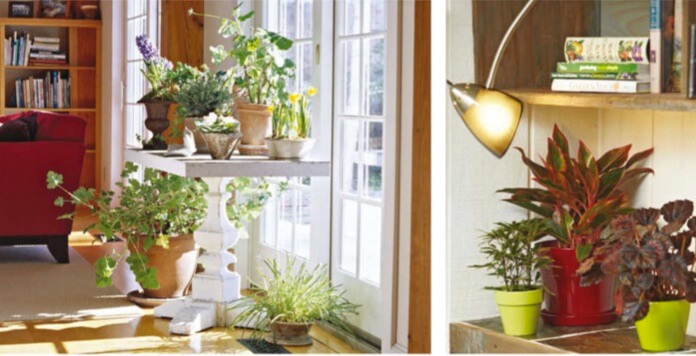
The Right Light
Light is vital to plants. Their ability to grow, maintain health, and produce flowers depends on light. If a plant is in more or less light than it needs for optimum growth, it will be stressed and more prone to problems, such as weak growth, minimal flowering, disease, and pests. Too much light may cause whitish scorched marks on foliage, wilted and shriveled leaves, or bleached leaves. Symptoms of insufficient light include stretching or leaning toward a light source; sparse or spindly growth; loss of foliage color or variegation; and smaller, thinner, easily damaged leaves.
Before you bring a plant indoors, identify the amount of light it will need and the location where that light is available. Experiment until you discover where the light in your home best suits a plant.
A plant tag usually tells you what level of light a plant needs: low, medium, or bright. Ideal light levels vary by plant species and sometimes by cultivar. Low light may be enough to keep a plant alive but not enough to promote flowering. Bright, direct light in a south- or west-facing window suits succulents and seedlings, but it could toast African violets and bromeliads. Look for shadows—the brighter the light, the stronger the shadows.
Intensity
The closer to a window, the more intense the light, depending on the geographic location and time of year. Sheer curtains diffuse bright light and help prevent the sunburning indicated by yellow- to brown-scorched leaves. Winter light is less intense than summer light, but it extends farther into a room because the sun is lower in the sky.
Quality
Sunlight is the best source of full-spectrum light for plants. Supplement natural light with artificial light to provide plants with the amount and quality of light (light wavelengths in the red-blue spectrum) they need to thrive.
Duration
Most indoor plants need 8 to 16 hours of light daily. Many plants’ blooms are triggered by day and night cycles.
Supplemental light
When natural light is inadequate, supplement it to help plants thrive, especially during winter. Seedlings and flowering houseplants, such as African violets and begonias, benefit from an added light source. Fluorescent tubes, including cool- and warm-white tubes, are available in various shapes and sizes at hardware stores. Full-spectrum fluorescent lights are best for plant growth, although fluorescent lights do help.
How to Water
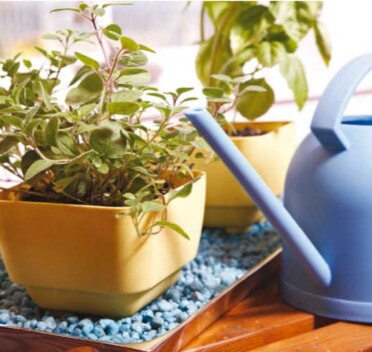
As with the other elements, a plant’s need for water is individual, and there are many variables. A plant’s needs change with the seasons, as plants absorb more water when the light is bright, temperature is high, and humidity is low. The thirstiest plants include those with flowers, large leaves, tropical or marshy origins, or large root balls in a confined space. A lightweight soilless potting mix dries out faster than heavy potting soil, and small pots dry out faster than large ones. Fast-growing plants (ferns, dracenas, palms) need more water than slower-growing ones (holiday cactus, Sansevieria).
Check the soil of indoor potted plants weekly by feeling the soil before watering or using a moisture meter. Using your finger as a dipstick, poke it into soil up to the first knuckle to determine if the soil has begun to dry; up to the second knuckle to feel for moisture. You will learn to feel the difference in soil that is dry, damp, moist, and wet, and when water should be added to maintain a level of moisture or dryness.
Overwatering is the single-most common cause of indoor plant death. Underwatering and overwatering can have the same symptoms: wilting, pale, lackluster, and dropping foliage. Without enough water, a plant becomes stunted; leaves turn yellow or brown. With too much water, roots can’t function normally and the plant suffocates.
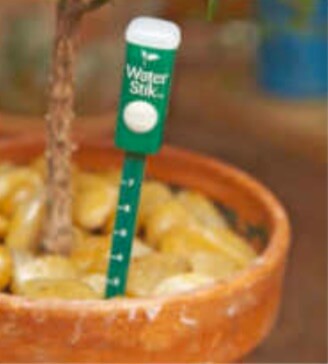
Each plant also has preferences for moisture and heat, depending on its origin from a tropical,
desert, or other climate. Most plants adjust to indoor conditions. As the conditions change seasonally, be aware of how your indoor plants will be affected.
Humidity
Moisture in the air is just as important to a plant as moisture in the soil. Warm air holds more water so humidity tends to be higher in the summer, although air conditioning lowers humidity. In
the winter, when a heating system dries the air, boost humidity by grouping plants or using a room vaporizer, a pebble tray for a potted plant, or a terrarium.
Temperature
The year-round temperature between 60°F and 75°F (and cooler at night) in typical homes suits most plants. Indoor temperatures vary from season to season, room to room, and within a room. Warm air rises, making a toasty place on top of a bookcase; cool air sinks, making the air near the floor cooler.
Air circulation
Movement of air benefits plants by evaporating moisture from leaves and preventing disease, promoting denser and sturdier growth, and keeping some insect populations in check. Open a window in mild weather to increase air circulation. In winter, move air with a ceiling fan or small fan placed near plants.

Plant Signals
Plants have ways of showing you when the conditions are not suitable. They show symptoms of stress that give you clues if a change is needed in their environment or care regimen.
Humidity
- Too little: Leaf tips brown and shrivel as on this fern; leaf edges turn yellow. Buds fall off and blossoms wither.
- Too much: Plants are more susceptible to rot, mold, and mildew.
Temperature
- Too cold: Leaves curl, turn black or brown, wilt, and fall off; buds drop when conditions are too chilly. Plant tissues, such as roots, can freeze and die.
- Too warm: Lower leaves wilt and turn brown. Flowers die quickly. The plant produces small leaves or weak, leggy growth.
Air circulation
- Too little: Fungal disease (powdery mildew, above,on rosemary) or insect problems (white flies) may proliferate.
- Too much: Wind shreds leaves, dries soil, and shakes off buds and flowers.
TIẾNG VIỆT
GET THE DIRT ON WHAT IT TAKES TO CULTIVATE HEALTHY PLANTS INDOORS. START WITH A FEW POTTING SOIL POINTERS AND FERTILIZER FACTS, THEN CHOOSE THE BEST CONTAINERS FOR YOUR PLANTS AND GIVE THEM THE RIGHT LIGHT AND WATER.
WRITER: KATE CARTER FREDERICK
PHOTOGRAPHERS: MARTY BALDWIN, BLAINE MOATS, AND DEAN SCHOEPPNER

![[Ebook] Indoor Gardening Houseplants 2016 USA Magazine – I – The Basics (Phần cơ bản) [Ebook] Indoor Gardening Houseplants 2016 USA Magazine – I – The Basics (Phần cơ bản)](https://vn1.vdrive.vn/codai.net/2021/02/ebook-indoor-gardening-houseplants-2016-usa-1-the-basics-01.jpg)


